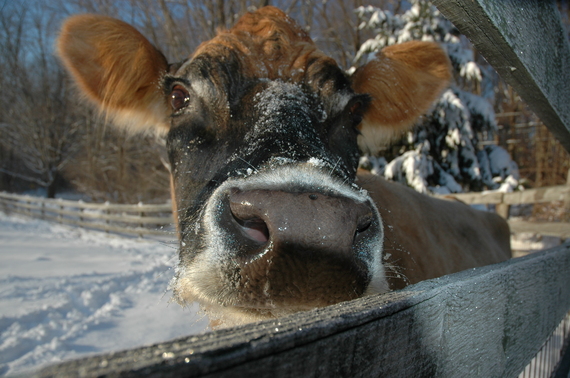July 12th was National Cow day: How did you celebrate it?
I may be a dog expert but the cow truly calls to me. Whether I'm taking a dog to visit a local herd or passing a farm along the highway I aways reflect upon the cow's peaceful nature. I envision them during my deep breathing exercises. To me, they are calm, patient, yet mindfully unyielding.
But dogs aren't always on the same page. Calm is not a word I'd use to describe most dogs facing up to a large, hooved animals.
Thankfully, when it comes to conditioning your dog to respect farm life or to play nice with a passing horse, your neighbor's pot-bellied pig or even deer in the field, look no further: cows rock.
If you need to condition your dog to big animals, cows are the ideal teaching aides. Here's why:
1)Cows -- especially those accustomed to noise, people, and other dogs - will rarely give, even a barking dog, more than a passing nod. Since prolonged stares from other animals can trigger a dog's fear or defensiveness, a passing nod is a better bet when conditioning your dog's tolerance level.
2)Cows move slowly, making them least likely to ignite a dog's chasing instinct.
3)Cows are food motivated (although they prefer grasses to liver treats) so most will keep eating even in the midst of barking and chaos.
Whatever large animal you hope to condition your dog or puppy to, go find a cow and get started.
WARNING: Always leash your dog or puppy when conditioning her to livestock, and stay at least 20 feet outside the other animal's enclosure. A cow may charge or kick a dog that enters their personal space.
Prerequisite: Teach your dog the meaning of "Find it." Watch my video to learn how to play the "Find it" game. This fun exercise will help you to positively redirect your dog's focus no matter what the distraction!
Take Alongs: When setting out, bring anything your dog loves to eat, chew or play with. Use rewards and distractions to positively engage your dog in the presence of an otherwise frustrating distraction (like a cow).
Step One
Start on an Empty Stomach
Wait to feed your dog until you see the cow. Help your dog associate cows to food treats and all his favorite things!
Step Two
Bring various treats and bones
Think about what rewards get your dog most excited and which ones barely raise her tail. Rate each from your dog's perspective and bring out the highest rewards when you're cow-side.
Step Three
Watch your dog's talking points
Calculate your dog's comfort zone. Dogs will startle to the site of farm animals unless conditioned to them from a young age. Watch your dog's talking points to determine how he feels: his eyes, ears, tail, and posture. Does your dog lean back? Translation: caution. Does he lean forward and bark? Translation: your dog is willing to use whatever means to defend himself.
Step Four
Determine your dog's comfort zone
If your dog's reacting, you're already standing too close. Stand as far away from the cow as you need to until your dog can stand comfortably. Now play the "Find it" game: Get a handful of high-value treats, say "Find it," and cast a handful of treats to the ground to distract your dog.
Step Five
Gradually move closer
Gradually lessen the distance to the cow as you increase the value of the treats. If your dog sneaks a peak, praise him! Tell him he's a good boy then take a few steps backward as you wave a treat in front of his face. Does he look to you? Super! If not you may be moving too close too quickly. Depending on your dog's reactivity you may need to repeat this adventure several times until your dog feels comfortable in the presence of this gentle giant.
Step Six
Rate your success
Success doesn't look particularly fancy. You don't want your dog prancing around carelessly or sulking behind you either. Success is a dog who can tolerate the presence of any other animal or person without getting riled up or reactive.
Wondering how you're progressing? Check back in with your dog's talking points -- eyes, ears, tail, posture -- and see what they have to tell you. "Relaxed" is good. "Bored" is even better.
And while you're at it, send us an update in the comment section below. A photo or short video, with dogs especially, is worth a thousand words.
